tow CHEVROLET BLAZER 1996 2.G Owners Manual
[x] Cancel search | Manufacturer: CHEVROLET, Model Year: 1996, Model line: BLAZER, Model: CHEVROLET BLAZER 1996 2.GPages: 392, PDF Size: 20.35 MB
Page 4 of 392
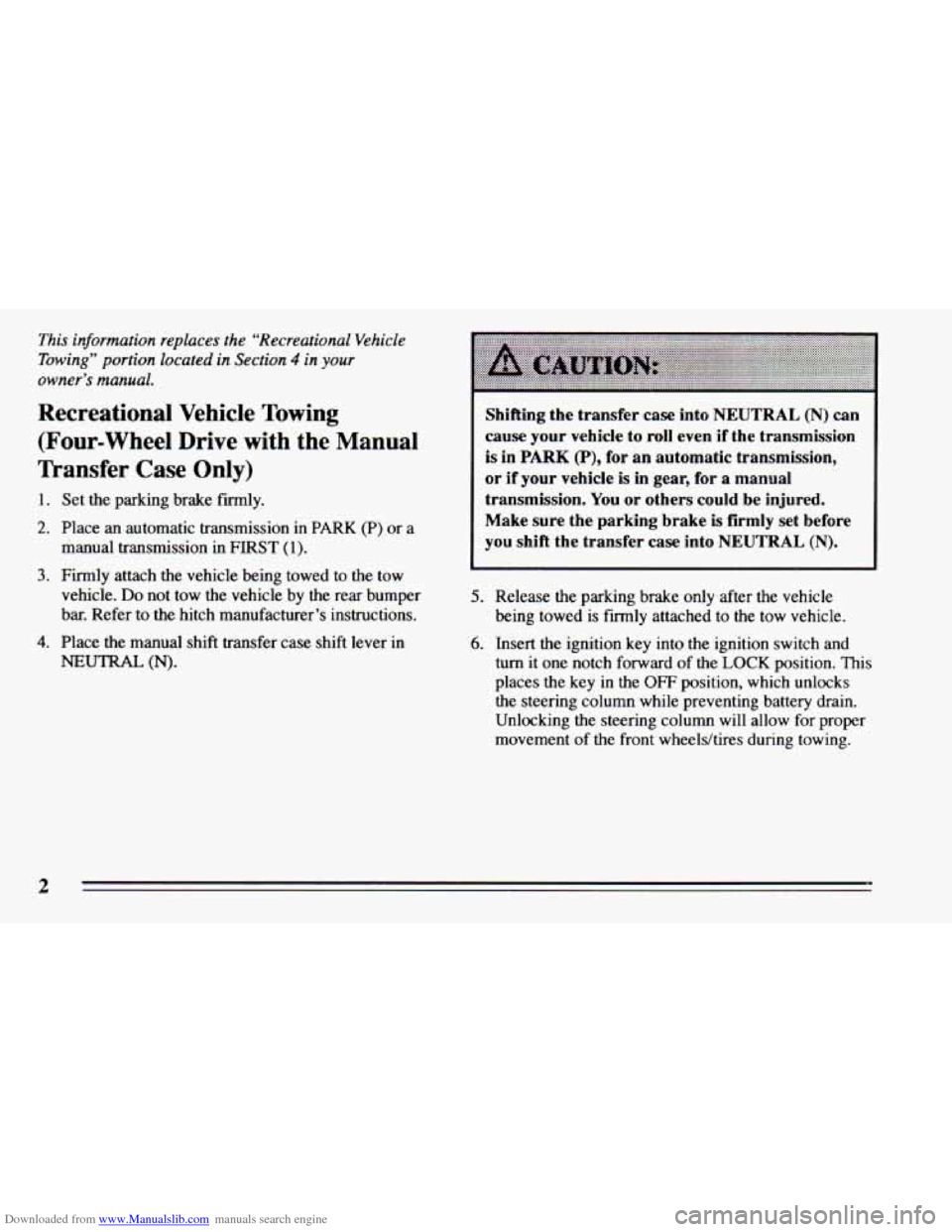
Downloaded from www.Manualslib.com manuals search engine This information replaces the “Recreational Vehicle
Towing”
portion located in Section 4 in your
owner’s manual.
Recreational Vehicle Towing
(Four-wheel Drive with the Manual
Transfer Case
Only)
1. Set the parking brake fiily.
2. Place an automatic transmission in PARK (P) or a
manual transmission
in FIRST (1).
3. Firmly attach the vehicle being towed to the tow
vehicle.
Do not tow the vehicle by the rear bumper
bar. Refer to the hitch manufacturer’s instructions.
4. Place the manual shift transfer case shift lever in
NEUTRAL (N).
Shifting the transfer case into NEUTRAL (N) can
cause your vehicle to
roll even if the transmission
is in PARK (P), for an automatic transmission,
or if your vehicle is in gear, for a manual
transmission. You
or others could be injured.
Make
sure the parking brake is firmly set before
you
shift the transfer case into NEUTRAL (N).
5. Release the parking brake only after the vehicle
being towed is firmly attached to the tow vehicle.
6. Insert the ignition key into the ignition switch and
turn it one notch forward of the LOCK position. This
places the key in the
OFF position, which unlocks
the steering column while preventing battery drain.
Unlocking the steering column will allow
for proper
movement of the front wheelskires during towing.
2
Page 5 of 392
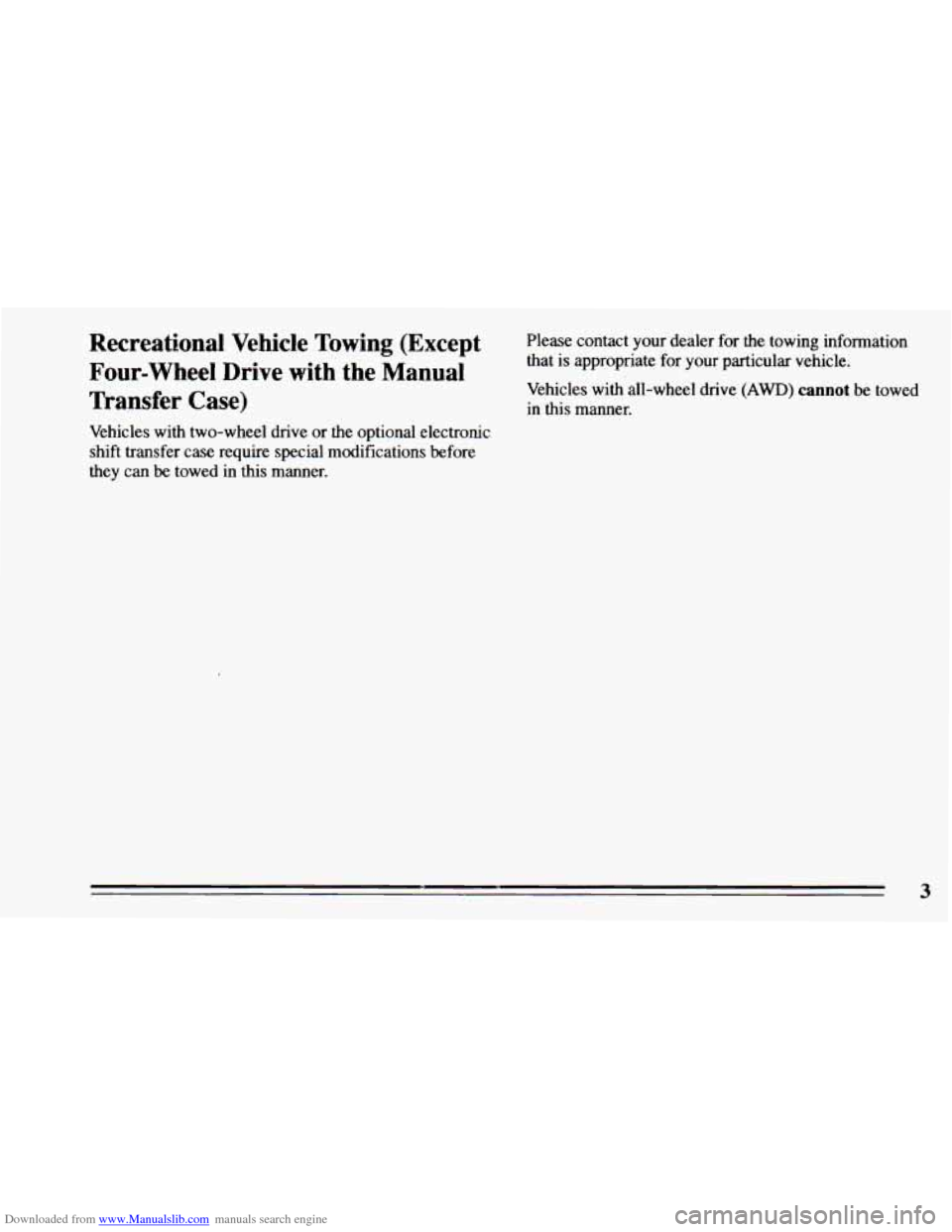
Downloaded from www.Manualslib.com manuals search engine Recreational Vehicle Towing (Except
Four-wheel Drive with the Manual
Transfer Case)
Vehicles with two-wheel drive or the optional electronic
shift transfer case require special modifications before
they can
be towed in this manner. Please
contact your dealer for the towing information
that is appropriate for your particular vehicle.
Vehicles with all-wheel drive
(AWD) cannot be towed
in this manner.
3
Page 13 of 392
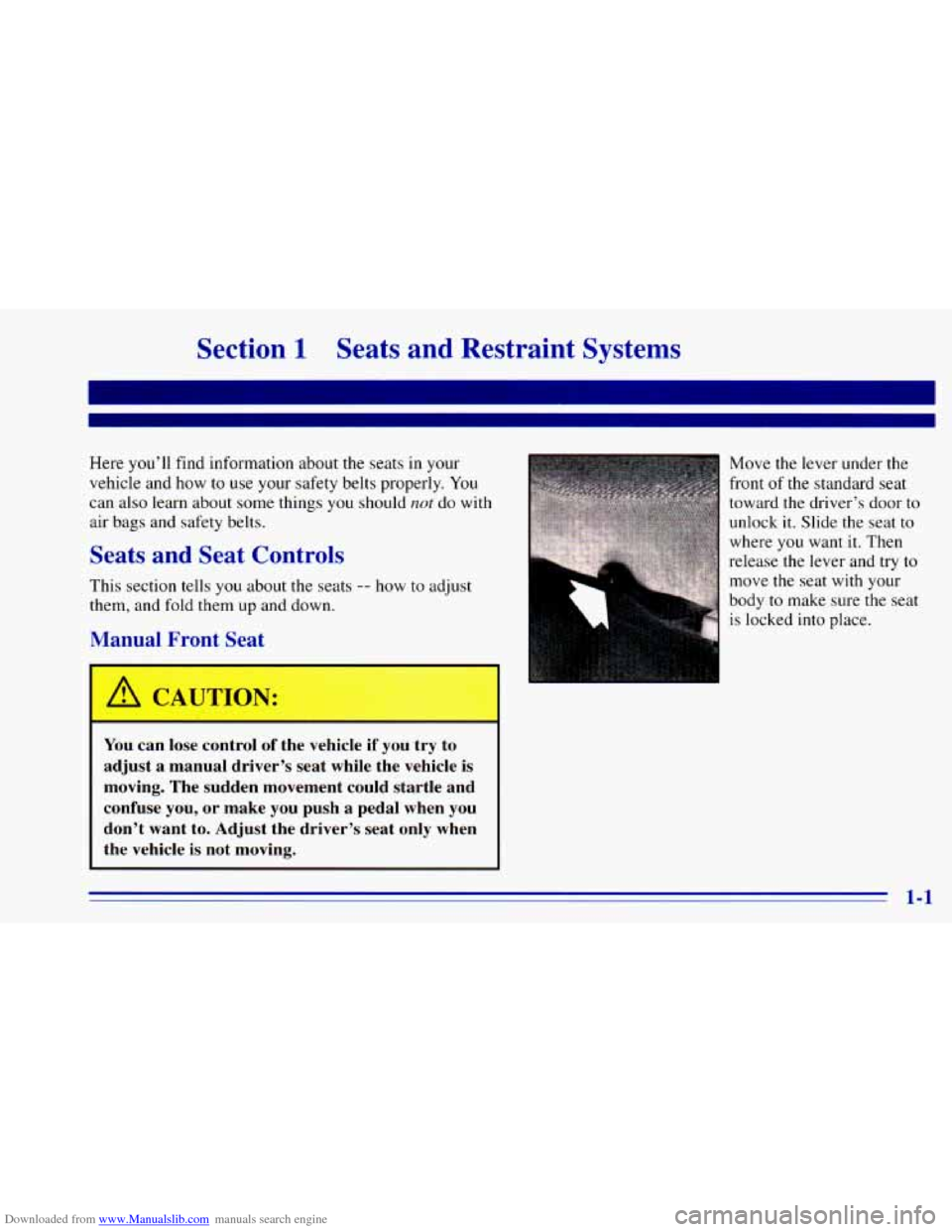
Downloaded from www.Manualslib.com manuals search engine Section 1 Seats and Restraint Systems
Here you’ll find information about the seats in your
vehicle and how
to use your safety belts properly. You
can also learn about some things you should not do with
air bags and safety belts.
Seats and Seat Controls
This section tells you about the seats -- how to adjust
them, and fold them up and down.
Manual Front Seat
You can lose control of the vehicle if you try to
adjust a manual driver’s seat while the vehicle is
moving. The sudden movement could startle and
confuse you, or make you push a pedal when you
don’t want
to. Adjust the driver’s seat only when
the vehicle
is not moving.
Move the lever under the
front of the standard seat
toward the driver’s door to
unlock
it. Slide the seat to
where
you want it. Then
release the lever and try to
move the seat with your
body,to make sure the seat
is locked into place.
1-1
Page 33 of 392
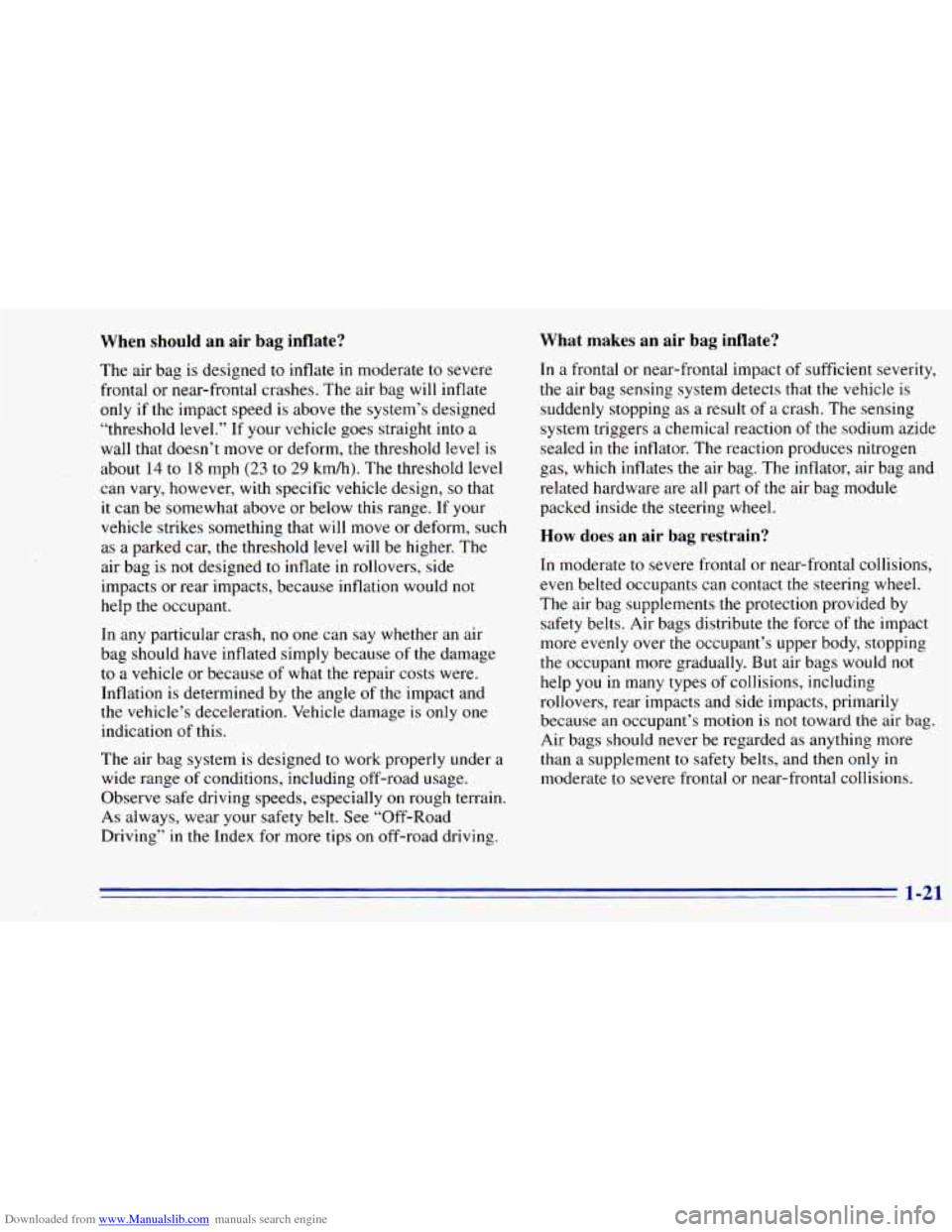
Downloaded from www.Manualslib.com manuals search engine When should an air bag inflate?
The air bag is designed to inflate in moaerate to severe
frontal or near-frontal crashes. The air bag will inflate
only if
the impact speed is above the system’s designed
“threshold level.” If your vehicle goes straight into a
wall that doesn’t move or deform, the threshold level is
about
14 to 18 mph (23 to 29 km/h). The threshold level
can vary, however, with specific vehicle design, so that
it can be somewhat above or below this range. If your
vehicle strikes something that will move or deform, such
as
a parked car, the threshold level will be higher. The .
air bag is not designed to inflate in rollovers, side
impacts or rear impacts, because inflation would not
help the occupant.
In any particular crash,
no one can say whether an air
bag should have inflated simply because
of the damage
to
a vehicle or because of what the repair costs were.
Inflation is determined by the angle of the impact and
the vehicle’s deceleration. Vehicle damage
is only one
indication
of this.
The air bag system is designed to work properly under a
wide range of conditions, including off-road usage.
Observe safe driving speeds, especially
on rough terrain.
As always, wear your safety belt. See “Off-Road
Driving” in the Index for more tips
on off-road driving.
What makes an air bag inflate?
In a frontal or near-frontal impact of sufficient severity,
the air bag sensing system detects that the vehicle is
suddenly stopping as a result of a crash. The sensing
system triggers
a chemical reaction of the sodium azide
sealed in
the inflator. The reaction produces nitrogen
gas, which inflates
the air bag. The inflator, air bag and
related hardware are all part of the air bag module
packed inside the steering wheel.
How does an air bag restrain?
In moderate to severe frontal or near-frontal collisions,
even belted occupants can contact the steering wheel.
The air bag supplements the protection provided by
safety belts. Air bags distribute the force
of the impact
more evenly over the occupant’s upper body, stopping
the occupant more gradually. But air bags would not
help you
in many types of collisions, including
rollovers, rear impacts and side impacts, primarily
because an occupant’s motion is not toward the air
bag.
Air bags should never be regarded as anything more
than a supplement
to safety belts, and then only in
moderate to severe frontal or near-frontal collisions.
1-21
Page 55 of 392
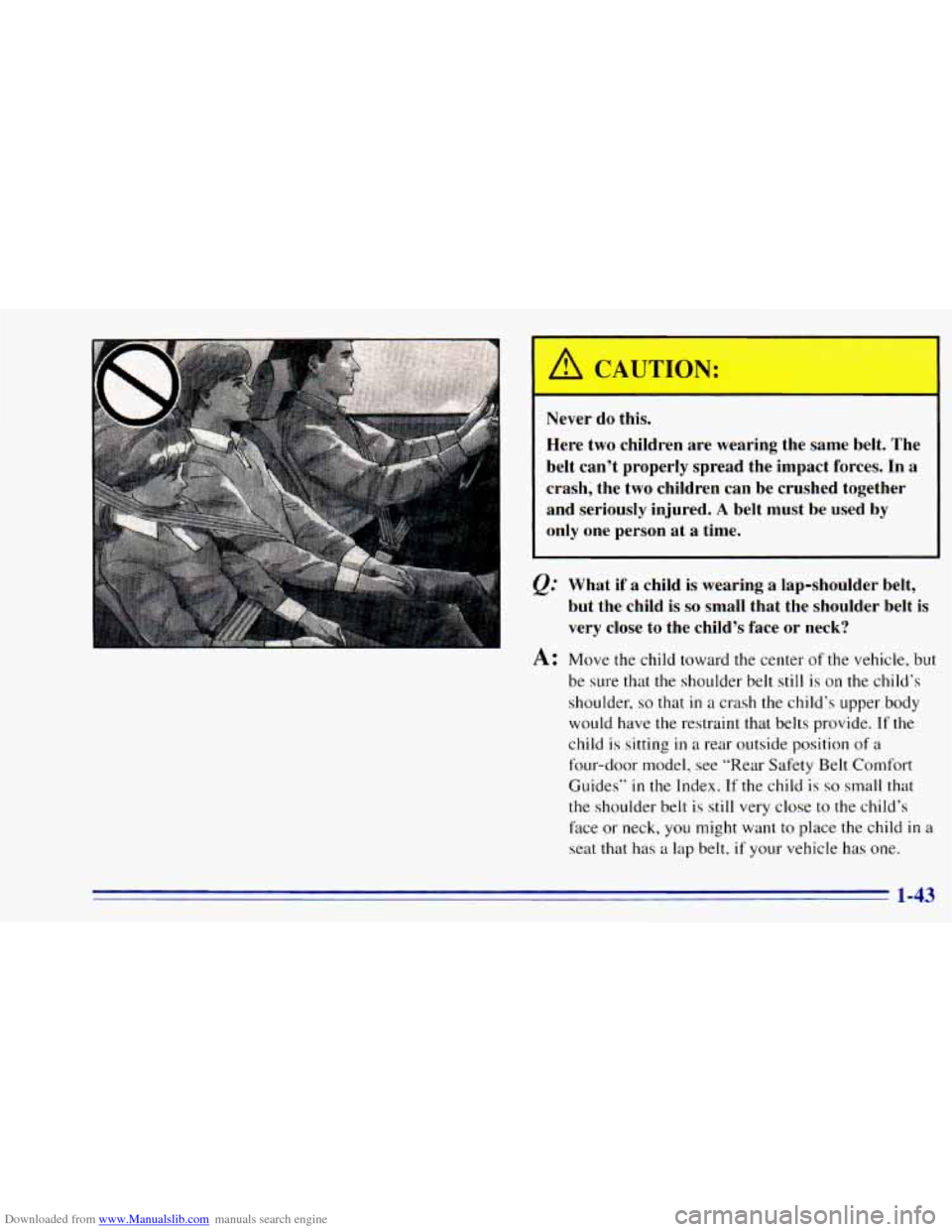
Downloaded from www.Manualslib.com manuals search engine ;his.
Here two children are wearing the same belt. The
belt can’t properly spread the impact forces. In
a
crash; the two children can be crushed together
and seriously injured.
A belt must be used by
only one person at a time.
&: What if a child is wearing a lap-shoulder belt,
but the child is
so small that the shoulder belt is
very close to the child’s face or neck?
A: Move the child toward the center of the vehicle, but
be sure that
the shoulder belt still is on the child’s
shoulder,
so that in a crash the child’s upper body
would have the restraint that belts provide.
If the
child is sitting
in a rear outside position of a
four-door model, see “Rear Safety Belt Comfort
Guides”
in the Index. If the child is so small that
the shoulder belt is still very close to the child’s
face or neck,
you might want to place the child in a
seat that has a lap belt,
if your vehicle has one.
1-43
Page 65 of 392
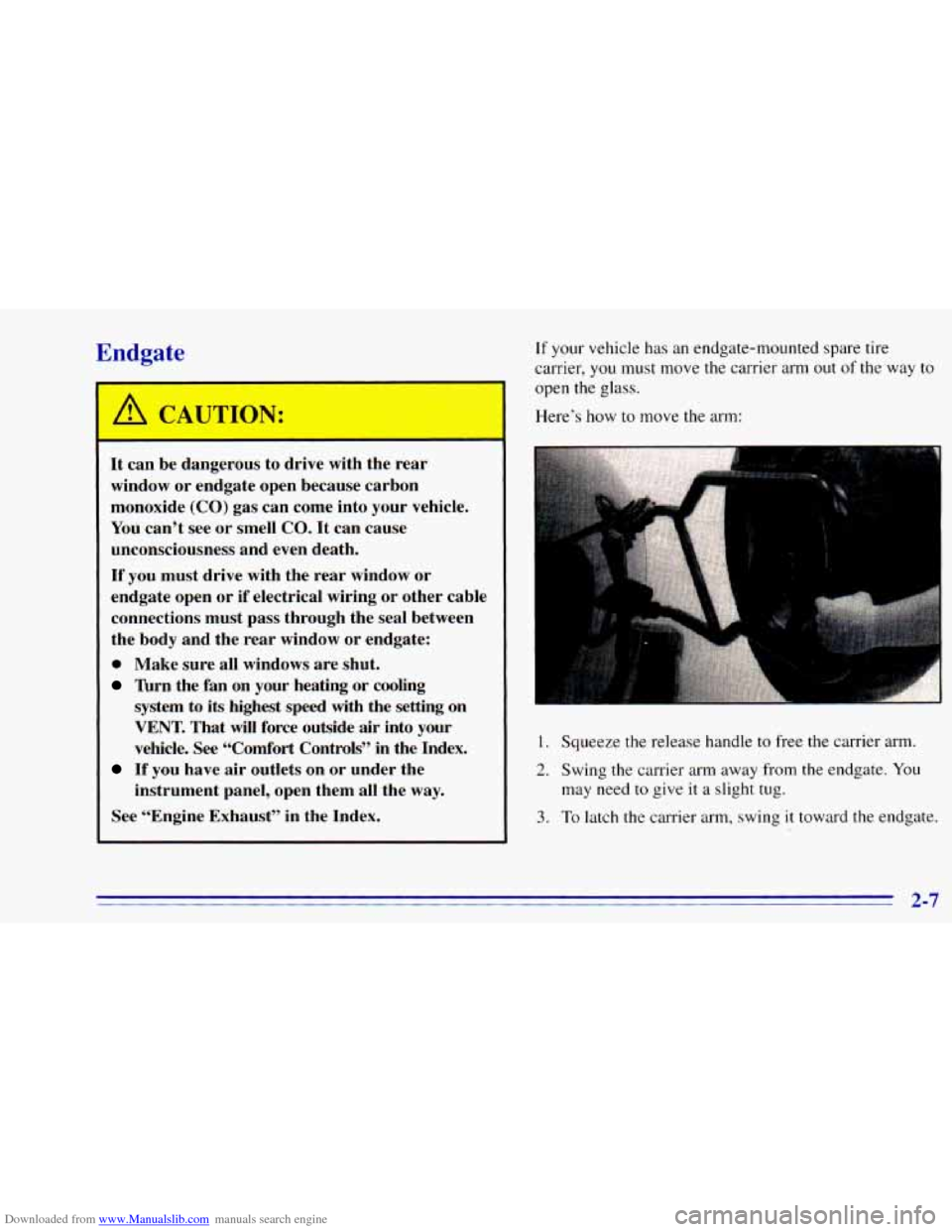
Downloaded from www.Manualslib.com manuals search engine Endgate
A CAUTION:
It can be dangerous to drive with the rear
window or endgate open because carbon
monoxide (CO) gas can come into your vehicle.
You can’t see or smell CO. It can cause
unconsciousness and even death.
If you must drive with the rear window or
endgate open or if electrical wiring or other cable
connections must pass through the seal between
the body and the rear window or endgate:
0 Make sure all windows are shut.
’hrn the fan on your heating or cooling
system to its highest speed with the setting on
VENT. That will force outside air into your
vehicle.
See “Comfort Controls” in the Index.
instrument panel, open them all the way.
If you have air outlets on or under the
See “Engine Exhaust” in the Index.
If your vehicle has an endgate-mounted spare tire
carrier,
you must move the carrier arm out of the way to
open the glass.
Here’s how to move the arm:
1. Squeeze the release handle to free the carrier arm.
2. Swing the carrier arm away from the endgate. You
3. To latch the carrier arm, swing it toward the endgate.
may need
to give it a slight
tug.
Page 67 of 392
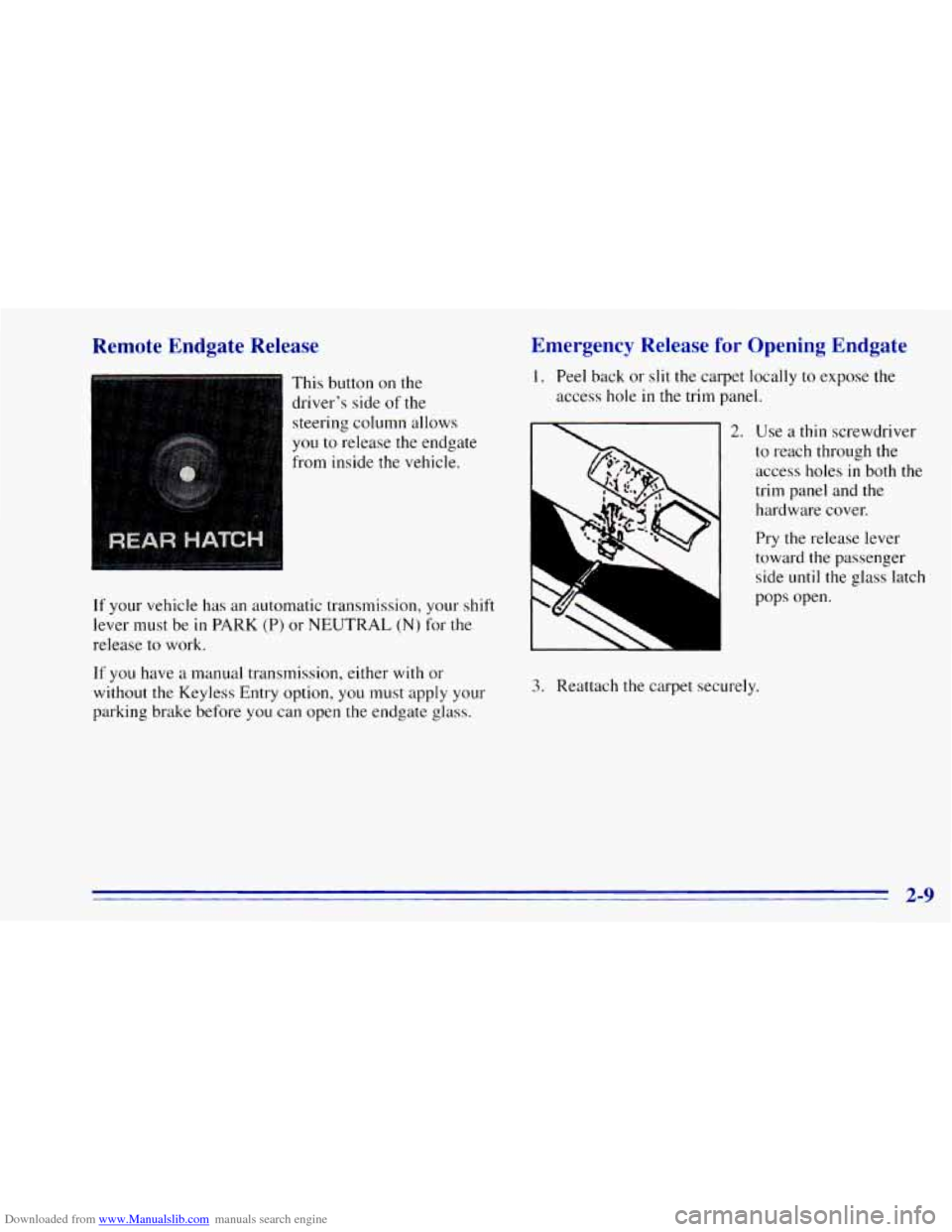
Downloaded from www.Manualslib.com manuals search engine Remote Endgate Release
This button on the
driver’s side of
the
steering column allows
you to release the endgate
from inside the vehicle.
If your vehicle has an automatic transmission, your shift
lever must be
in PARK (P) or NEUTRAL (N) for the
release to work.
If you have a manual transmission, either with or
without the Keyless Entry option, you must apply your
parking brake before you can open
the endgate glass.
Emergency Release for Opening Endgate
1. Peel back or slit the carpet locally to expose the
access hole
in the trim panel.
2. Use a thin screwdriver
to reach through the
access holes
in both the
trim panel and
the
hardware cover.
Pry the release lever
toward the passenger
side
until the glass latch
L
PSJ
pops open.
3. Reattach the carpet securely.
2-9
Page 69 of 392
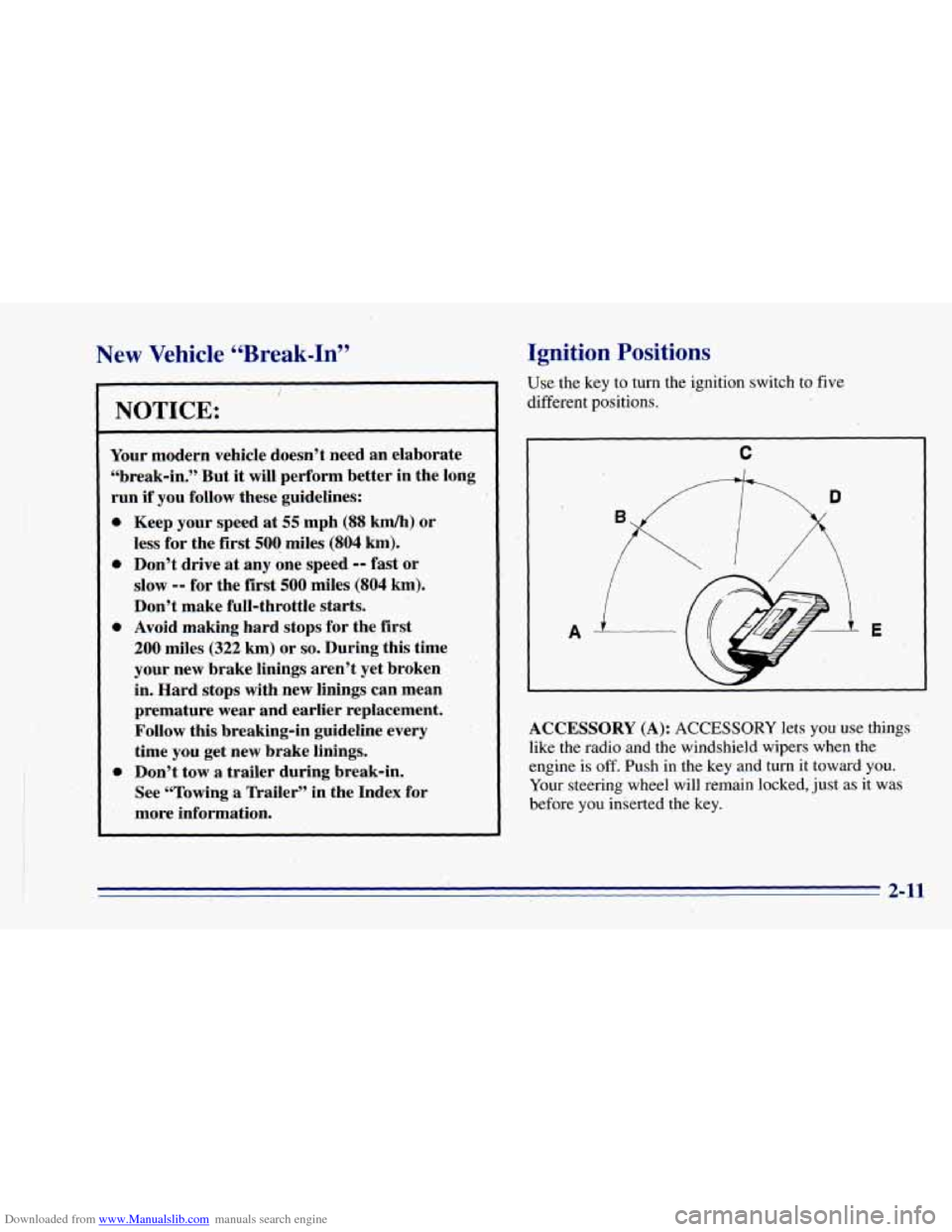
Downloaded from www.Manualslib.com manuals search engine ’ , ‘J’ =
New Vehicle “Break-In”
i
NOTICE:
Your modern vehicle doesn’t need an elaborate
“break-in.” But
it will perform better in the long
run
if you follow these.guidelines:
e
e
e
e
Keep your speed at 55 mph (88 km/h) or
less for the first
500 miles (804 km).
Don’t drive at any one speed
-- fast or
slow -- for the first 500 miles (804 km).
Don’t make full-throttle starts.
Avoid making hard stops for the
first
200 miles (322 km) or so. During this time’
your new brake linings aren’t yet broken
, .
in. Hard stops with new linings can mean
premature wear and earlier replacement.
Follow this breaking-in guideline every
time you get new brake linings.
Don’t tow
a trailer during break-in.
See “Towing
a Trailer” in the Index for
more information.
Ignition Positions
USE the key to turn the ignition switch to five
different positions.
C
I
ACCESSORY (A): ACCESSORY lets you use things
like the radio and the windshield wipers when the
engine
is off. Push in the key and-turn it toward you.
Your steering wheel will remain locked, just as it was
before you inserted the key.
2-11
Page 70 of 392
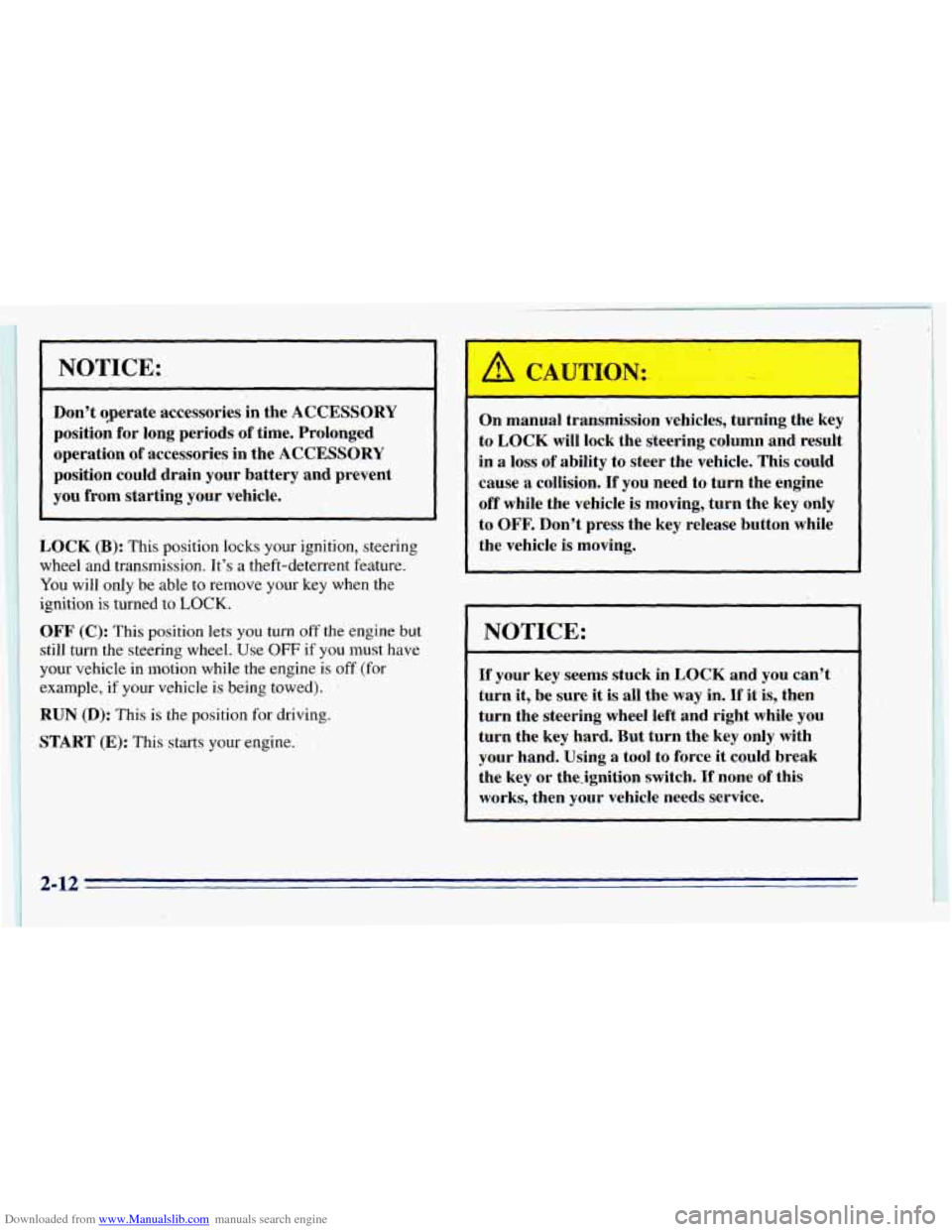
Downloaded from www.Manualslib.com manuals search engine I.
u.
.NOTICE.:
I
Don’t operate accessories in the ACCESSORY
positio; for long periods of time. Prolonged
operation
of accessories in the ACCESSORY
position could drain your battery and prevent
you from starting your vehicle.
LOCK
(B): This position locks your ignition, steering
wheel and transmission. It’s
a theft-deterrent feature.
You will only be able
to remove your key when the
ignition
is turned to LOCK.
OFF (C): This position lets you turn off the engine but
still turn the steering wheel. Use
OFF if you must have
your vehicle in motion while the engine is off (for
example, if your vehicle is being towed).
I
RUN (D): This is the position for driving.
START (E):. This starts your engine.
I .. , . . ..
A CAUTION:
On manual transmission vehicles, turning the key
to LOCK will lock the steering column and result
in a loss of ability
to steer the vehicle. This could
cause
a collision. If you need to turn the engine
off while the vehicle is moving, turn the key only
to
OFF. Don’t press the key, release button while
the vehicle
is moving.
NOTICE:
If your key seems stuck in LOCK and you can’t
turn it, be sure it is all the way in:If itis, then
turn the steering wheel left and right while you
turn the key hard. But turn the key only with
your hand. Using a tool to force it could break
the key or the-ignition switch.
If none of this
works, then your vehicle needs service.
Page 72 of 392
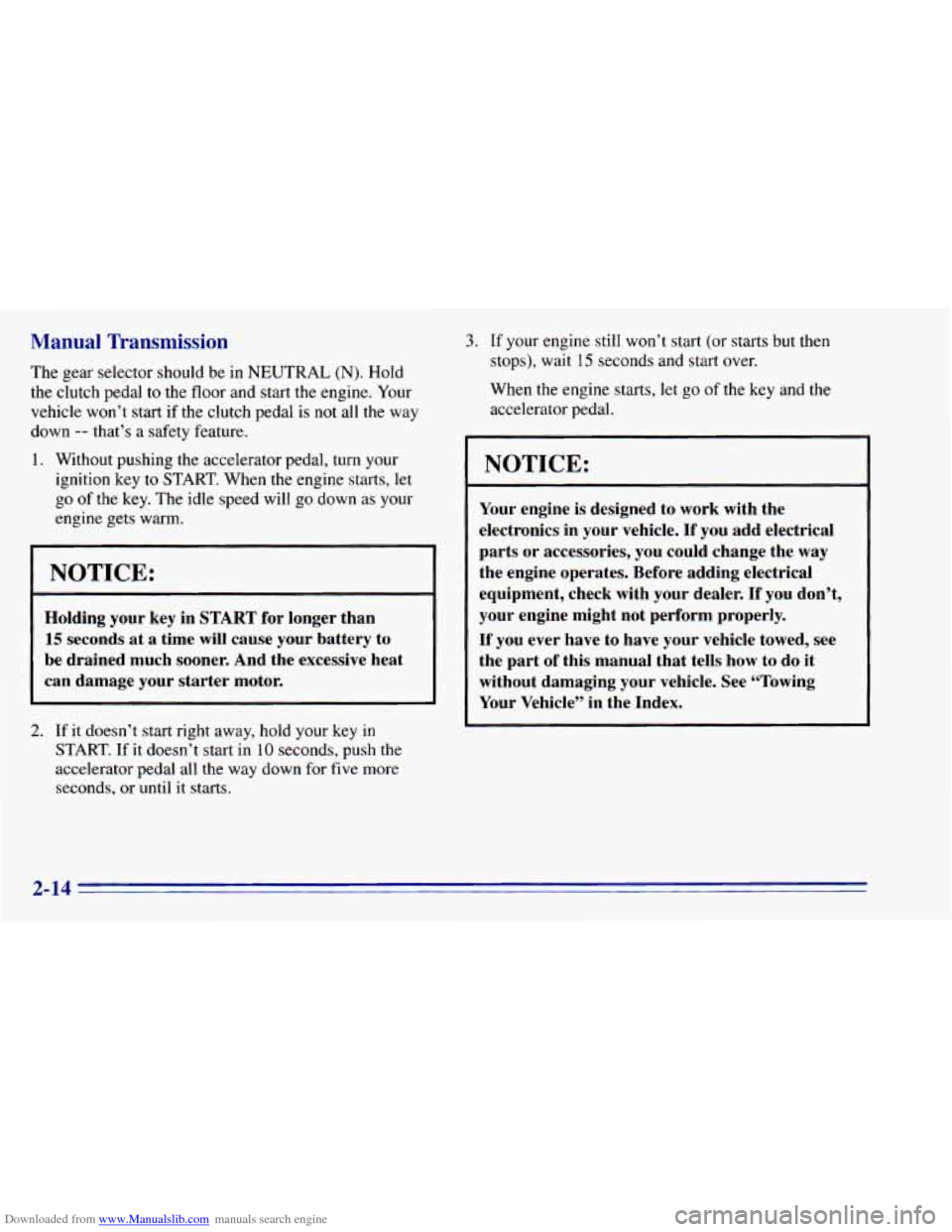
Downloaded from www.Manualslib.com manuals search engine Manual Transmission
The ge ector should be in NEUTRAL (N). Hold
the clutch pedal to the floor and start the engine. Your
vehicle won’t start
if the clutch pedal is not all the way
down
-- that’s a safety feature.
1. Without pushing the accelerator pedal, turn your
ignition key to START. When the engine starts, let
go of the key. The idle speed
will go down as’ your
engine gets warm.
NOTICE:
Holding your key in START for longer than
15 seconds at a time will cause your battery to
be drained much sooner. And the excessive heat
can damage your starter motor.
2. If it doesn’t start right away, hold your key in
START. If it doesn’t start in
10 seconds, push the
accelerator pedal all the way down for five more
seconds, or until it starts.
3. If your engine still won’t start (or starts but then
stops), wait
15 seconds and start over.
When the engine starts, let
go of the key and the
accelerator pedal.
NOTICE:
Your engine is designed to work with the
electronics in your vehicle. If you add electrical
parts or accessories, you could change the
way
the engine operates. Before adding electrical
equipment, check with your dealer. If you don’t,
your engine might not perform properly.
If you ever have to have your vehicle towed, see
the part
of this manual that tells how to do it
without damaging your vehicle. See “Towing
Your Vehicle’’ in the Index.
2-14